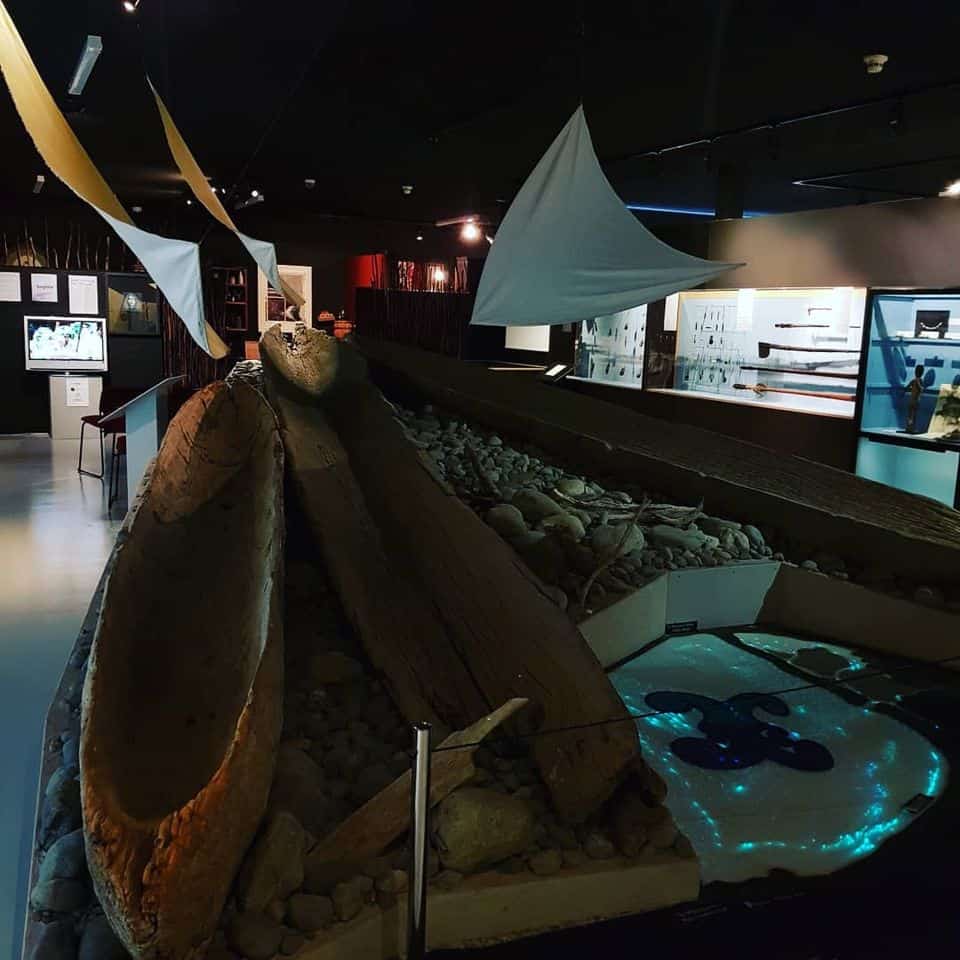Rob | Posted on | No Comments |
Challenging Conversations – The Wairau, 1843

Following the Wairau Affray production last night, there was a discussion by led by Dr Lloyd Carpenter and Dr Peter Meihana. This was a 2 hour lecture style presentation on the people, events and attitude around the time of the incident. A well timed event.
It appears that there is all this stuff at the moment around the Wairau Affray, including the play, this lecture as well as the art exhibition at the Blenheim Art Gallery.
The discussion was very good. It went through all the references and little pieces that were related to the affray, but were not fully mentioned in the play. Some points that Lloyd went through were Blenkinsops initial agreement, Te Rongo’s initial husband and his trip to England, the environment of Nelson in the early days of settlement. Views and sources were all part of the information and it was well worth the time.
I hope that this will become a permanent accompaniment to the play, however I believe this to have been a special occurrence.
Challenging Conversations was a lecture about the Wairau Affray and what happened in the build up to the event on the day. This event was mainly hosted by Lloyd Carpenter, a Doctor of History from Lincoln University. He is also related through Nohorua and has links to both sides of the Affray.
Lloyd started briefly with the Blenkinsop Deed, which he explained as an agreement about access to water and timber for the sale of a cannon, in which Blenkinsop also added an amendment which got past everyone, which was not insignificant as it was for the whole of the Wairau planes. Written in English, which Te Rauparaha could not read, was told after the fact by a whaler, which triggered him to throw his copy into the fire and send the cannon back.
I believe there is more to this story and I have got a book on Blenkinsop to hopefully fill out some more detail on this.
Lloyd then moved Te Rongos previous husband. Te Rongo was Rangihaeata’s recent wife who died at the Affray and sent Rangihaeata into a rage in which caused all the hostages to be killed.
I cannot remember his name, but Te Rongos previous husband was thought to have been an important tribal member due to the markings on his face. He was sent to France to meet the French Royalty however his minder died on the voyage and he was stuck in France unable to speak to anyone as he did not know French, and no one knew Maori.
Edward Gibbon Wakefield heard about this and invited him to stay with him in England. This was before the New Zealand Company was created, however Arthur had thought that he could use him and his stature to talk with the natives when negotiating land purchases.
He stayed in England for 2 years and when he returned to New Zealand with Arthur, in European clothes, the tribe laughed at him. When questioned about him being a chief, the response was “He is no chief, he is not even a chiefs arsehole”
Te Rongo was a high ranking royal, and this event with her husband had reduced her Mana. Unfortunately her husband soon died of TB which seemed to happen frequently to Maori who went to England. This meant that Te Rongo had an opportunity to restore her Mana with a new husband. In comes Rangihaeata and his tall stature. The marriage between Te Rongo and Rangihaeata was supposedly more beneficial to Rangihaeata due to her royal status.
Parking the Blenkinsop discussion, and Te Rongo and her previous husband, Lloyd then moved his discussion to Nelson. Nelson was the 2nd colony for the New Zealand Company after Port Nicholson or Wellington. The town was not a paradise environment to start. One ship with colonists set for Nelson sank killing all on board. This made it a solemn place to live.
He discussed the Murder of a Maori woman by one of the colonists who got off with no charge as his wife who witnessed the event could not testify against him due to the law at the time.
Lloyd discussed Police Magistrate Thompson, who he described as a buffoon. It appears that his temper was well known and his glowing reference were used to get him as far away as possible, in this case on the other side of the planet.
It also appears that Arthur Wakefield was aware of his temper and gave him many positions but did not make him a judge.
Lloyd discussed Thompson’s previous encounter with the Maori tribe in Takaka. The Maori had a deal allowing colonists to remove coal as they didn’t use it for anything. Coal taints the flavour of food and was deemed useless. When the Chief complained about colonists with no prior agreement, taking coal and leaving all the waist gear in the pits when they finished digging for coal, Thompson went out to see him. In front of the entire tribe, Thompson then punched the Chief, told him to accept that that is what happens then promptly left. This made Thompson think he could handle the natives in future meetings as this appeared to work. What actually happened was that the Maori who were there, where dumbfounded, striking a Chief was simply never done. As a result they were stunned in what happened and let Thompson leave without any retaliation. Luckily for Thompson, the Chief had died no more than 6 months later. It is said that the tribe were preparing to do something severe however revenge dies with the person in Maori culture, had the Chief had lived longer, the tribe would have wiped the Nelson European settlers of the face of the planet in retribution.
Lloyd did admire Arthur Wakefield and believed him to be a genuinely good man at heart, and believed main problem was with Thompson. Wakefield was under immense pressure to sell land to the incoming settlers that they simply did not have. Various agreements including the Blenkinsop deed, presented the Wairau as a silver bullet to solve this problem.
Te Rauparaha and Rangihaeata had meet with Wakefield and Thompson to discuss the settlement of the Wairau, Te Rauparaha insisted on waiting for Land Commissioner William Spain to rule on this issue and to stay away until then. He also stated that if settlers did come they would not be harmed. Thompson dismissed them with the same attitude he had with his previous encounters.
Nohorua, Te Rauparaha’s half brother also had a meeting with Wakefield and Thompson to warn them not engage with Te Rauparaha. This meeting was short, and he was also dismissed in a similar manner.
When Te Rauparaha was alerted of surveyors arriving into the Wairau, he escorted back to their ships, he had other tribe members pick up all the gear and gave it back to the settlers at port, then burned down their huts. This prompted Wakefield most likely under advisement from Thompson into action.
The prison boat which was currently in the harbor was commandeered to travel to the Tua Marina to arrest Te Rauparaha and Rangihaeata for the destruction of surveyors property. If this had arrived 2 weeks later it might have given precious time for them to have come to a different conclusion.
Wakefield and Thompson gathered as many settlers as they could a lot of them Quakers. Anyone who had a weapon, it didn’t matter what condition it was in, was gathered to join the party. There was a group of people working on the road who were rounded up on the way to the boat, these people did not have a chance to go home and say good bye or get weapons, and many of these people died during the incident.
Lloyd then spoke about the meeting at Tua Marina, in which Wakefield and Thompson confronted Te Rauparaha regarding the charges. Thompson slapped away Te Rauparaha’s hand when he extended it to shake hands. Te Rauparaha responded to the charges stating that since the surveyors on his land were using his timber to build their huts, he was in fact burning his own property. Te Rauparaha was still urging Wakefield to stand down and wait for Spain to give his ruling before doing anything.
Lloyd went into Te Rauparaha’s 3 sons, who had all turned Christian. Rawiri Kingi Puaha was there, preaching peace in both Maori and English to avoid fighting, however this did not work.
Lloyd then explained the event as it happened, from the shot coming from the settlers side, which had come from several first account testimony from the settlers, to the battle, the retreat, the surrender, and finally the executions.
Rangihaeata, was demanding invasion for the death of his high born wife, after a discussion he was the one who killed Wakefield and Thompson and the other Maori warriors killed the other settlers. They left the bodies in a circle and with Wakefield, they left his weapon draped across his neck which is said to be an insult to Wakefield, he could have spoken up and prevented all this death but choose not to.
In Summary, Lloyd explained how usually you would hear about the British abiding by the law, and the natives, with some sort of misunderstanding breaking the law, however this was just the opposite, the British where trying to avoid the law and the treaty of Waitangi. The Maori were insistent on waiting for ruling and avoided conflict where possible.
He also went on to say that the arrogant attitude that came from the representatives of the New Zealand Company was from the British attitude of the time. These people were not New Zealanders, they were British, part of the class system, and no way reflect the current attitude of British people today.
Peter Meihana briefly mentioned how land ownership was perceived amongst the Maori people. He stated that although Ngati Toa had conquered the area and the rest of the tribes understood they had the rights to the land. Other tribes and even previous enemies still occupied parts of the land and that was accepted by all.
Peter also inserted the challenges for the future, which include finding out why various people were at the affray, some of them were enemies of Te Rauparaha who had fought him only 13 years earlier. Were they there to support Te Rauparaha and the Maori people, or were they there to help their own agenda?

Leave a Reply